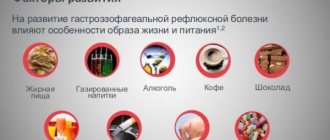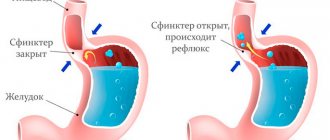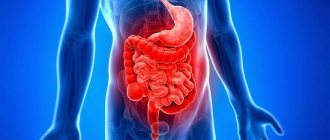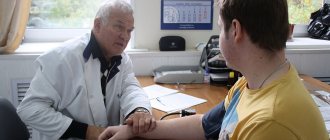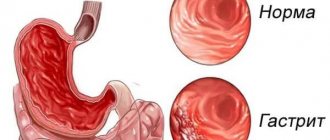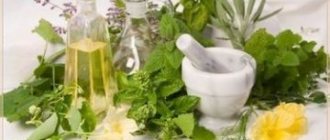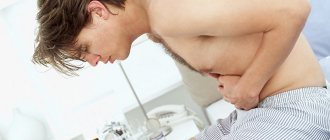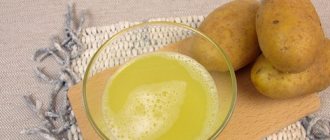How is biliary reflux gastritis and reflux esophagitis treated?
Treatment – How is biliary reflux gastritis and reflux esophagitis treated?
How is biliary reflux gastritis and reflux esophagitis treated - Treatment
When considering this topic, you should define the concept of “reflux”. So, reflux is a condition during which a reverse flow of the contents of one or another organ occurs, and in this particular case, the stomach. Inside this organ, the concentration of digestive juice is not the same, namely, at the bottom of the gastric sac it is in greater quantity than at the exit from it, where there is a lot of bicarbonates, which are needed for the process of neutralizing food. The intestines are characterized by an alkaline environment, and the appropriate functioning of the sphincters does not allow acidic juice to enter there.
Pathological processes in the human body affect the defense mechanisms, disrupting them in the antrum. As a result, gastric juice enters the intestinal cavity, and its contents, accordingly, are sent back to the stomach. This kind of deviation means gastric reflux. When the acidic environment is disturbed, foci of inflammation are formed, and this causes the development of reflux gastritis.
Reflux gastritis is divided into two types:
- biliary – the development process occurs in the stomach;
- duodenal - formation occurs in the duodenum.
Medicine also identifies such a concept as “reflux esophagitis,” which implies regular release of stomach contents into the esophagus.
Diet for reflux gastritis
Treatment
The goals of therapy are to eliminate negative symptoms, the causes of the disease, and stop the inflammatory process. Treatment of reflux gastritis is carried out comprehensively and has several directions. This is the use of medications, folk remedies, and physiotherapeutic procedures. Diet for reflux gastritis is of particular importance. Completing a therapeutic course requires constant medical supervision.
Drug therapy
Taking medications has different purposes:
- To reduce the production of gastric juice, Omeprazole and Ranitidine are prescribed.
- Improvement of peristalsis is provided by Itomed, Motilium.
- Prebiotics help restore digestive processes; for dysbacteriosis - Bifiform, Linex.
- For gastritis that is infectious in nature, drug treatment cannot be done without antibacterial agents.
- Protection of the mucous membrane from aggressive influences will be ensured by taking medications such as Venter, Denol.
To replenish missing enzymes, replacement therapy is prescribed using Festal, Mezim.
Physiotherapy
Physiotherapeutic procedures are part of the treatment course, helping to speed up the healing process. Prescribed during remission, after healing of ulcers. For the erosive form of the disease, physiotherapy is not used.
The main procedures that help get rid of reflux gastritis are phonophoresis and electrophoresis. The duration of the course is 10–14 days, depending on the severity of the disease and the characteristics of the patient’s body.
Folk remedies
People have known for a long time what reflux gastritis is. For many hundreds of years, ass
Long before the invention of drugs, many ways were found to combat its symptoms with the help of medicinal plants. It should be remembered that such methods can only be used during remission. The most popular traditional medicine recipes in the fight against reflux gastritis:
- Dandelion flower syrup. Cover the collected flowers with sugar and mash thoroughly until the juice appears; you can let it brew for a while. For preventive purposes, the resulting syrup is taken once a day, a teaspoon before meals. For 30 flowers you will need 3 tablespoons of sugar.
- Chamomile tincture is an excellent antispasmodic agent with a disinfecting effect. For 1.5 cups of boiling water, take one spoon of raw material. Infuse for an hour, drink a little throughout the day.
- Juice obtained from celery root. Take one spoon 30 minutes before meals.
- St. John's wort infusion has an anti-inflammatory and analgesic effect.
For reflux gastritis, treatment with folk remedies must be agreed upon with the attending physician.
Surgical intervention
In case of complications that cannot be cured with conservative therapy, surgical treatment is prescribed. Indications for it:
- The appearance of neoplasms.
- Congenital pathologies associated with pyloric insufficiency.
- Deep ulcers, erosions, causing severe bleeding.
- Scar formation.
In most cases, it is possible to avoid surgical intervention if the disease is diagnosed in time.
Recommendations for proper nutrition
Diet for reflux gastritis and adherence to the diet are the most important conditions for recovery. The diet is designed in such a way as to improve intestinal motility, normalize the microflora inside it, and reduce the level of acidity.
List of foods prohibited for gastritis:
- Semi-finished products and fast foods.
- Fried, spicy, salty dishes.
- Alcoholic drinks, carbonated water.
- Products with dyes and food additives.
- Flour products, baked goods, sweets.
- Pickled and canned foods.
- Sauces and seasonings.
- Dairy products.
- Strong tea, coffee.
- Vegetables and greens in raw form.
It is important not only to adhere to a diet for reflux gastritis, but also to the basic principles of a healthy diet. You need to eat in small portions, but often, and at the same time. The temperature of the food should be optimal so as not to injure the walls of the stomach. It is recommended to cook by boiling, baking or steaming.
Dietary nutrition for reflux gastritis is developed by the doctor, taking into account the individual characteristics of the patient. A sample menu might look like this:
For breakfast – pureed porridge, soft-boiled egg, cottage cheese, weak tea with added milk.
For lunch - slimy soup (milk, vegetable), meatballs from lean meats (boiled or steamed) or fish with stewed vegetables.
Afternoon snack – cottage cheese, jelly.
For dinner - porridge, bread with a piece of butter, compote. The last meal is taken an hour before bedtime. It can be boiled milk with crackers or jelly.
It is advisable to create a similar diet for at least a week. People who have suffered from gastritis should adhere to such a diet for the rest of their lives.
It is especially important to follow a diet for reflux gastritis in the acute stage.
What is biliary reflux gastritis?
This pathology develops due to irregular activity of the sphincters, as well as disturbances in motor functions and bile ducts.
In some cases, biliary reflux gastritis can be combined with the duodenal type of the disease. Digested food, together with enzymes secreted by the intestines and pancreas, returns back to the stomach. The walls of the stomach are affected by bile, the mucous membrane is burned and irritated. As a result of the fact that bile is secreted and food goes back, the intestinal walls also become inflamed and irritated.
This form of gastritis develops due to the influence of certain factors, namely:
- defects in the motor functions of the system responsible for the excretion of bile;
- poor tone of the muscle valve, which is located in the papilla of Vater of the duodenum;
- inflammatory processes of the upper intestines;
- modifications of the pylorus of a pathological nature, as a result of which it begins to close worse.
Other research methods
There are times when a patient needs to undergo a biopsy. The material for this study is taken from the mucous membrane of the organ. During examination of the biopsy specimen, cell necrosis, hyperplasia, and edema are revealed. Endoscopy is also often done. When necessary, pH testing is performed to determine the acidity in the stomach. Additional research methods are fluoroscopy. In addition to all of the above, analysis of vomit and detection of bile in the gastric juice help identify the presence of biliary reflux gastritis.
Main symptoms and methods of treatment of biliary reflux gastritis
The presented pathology is manifested by signs that are classic for gastritis:
- aching pain that often occurs after eating, but sometimes it may not bother you;
- feeling of heaviness and bloating in the stomach after eating;
- the appearance of gag reflexes;
- stool has a liquid or solid consistency;
- the appearance of belching, heartburn.
Biliary reflux gastritis is characterized by atypical symptoms:
- the appearance of a feeling of weakness;
- frequent occurrence of fatigue;
- the skin becomes excessively dry;
- body weight decreases noticeably and without reason;
- formation of jams in the corners of the mouth;
- development of anemia.
If such signs appear, you should immediately consult a doctor.
As for treatment, it can have two directions. With the help of medications, it is possible to eliminate unpleasant painful symptoms, eliminate inflammation, restore digestive functions, as well as motility of the biliary system. Medication-based therapy should last approximately two weeks.
The second direction of therapy is a thorough correction of the diet. A sick person must strictly follow diet No. 1. This diet implies the complete exclusion of spicy, fried, and fatty foods. Preference should be given to liquid and light dishes. After eating, you should not lie down or bend over. You should also control the amount of food you eat and avoid overeating. It is forbidden to rest on pillows that are too high and to be too nervous.
Treatment of the disease
Treatment of inflammation of the esophageal mucosa caused by exposure to hydrochloric acid and bile is complex. It combines taking medications and adjusting the patient’s diet. Without a special diet, it is almost impossible to overcome the disease.
Drug therapy usually includes drugs that help:
- stop the process of irritation of the stomach walls;
- restore normal digestion and maximum absorption of nutrients;
- normalize gastrointestinal motility;
- remove excess bile from the body (the most popular drugs for this action are “Holosas”, “Ursosan”).
What is reflux esophagitis?
When stomach contents enter the esophagus, a process of irritation and inflammation occurs, as a result of which doctors diagnose “reflux esophagitis.” This pathology develops for the following reasons:
- presence of bad habits;
- the use of certain medications that affect the condition of the sphincters;
- development of peptic ulcers;
- the vascular system is destroyed by inflammation;
- presence of excess weight;
- the appearance of pyloric convulsions;
- the presence of previous operations on the esophagus, as well as on organs located next to it;
- the development of gastritis, which was caused by the bacterium Helicobacter pylori;
- pregnancy at any stage.
It is worth noting that the simultaneous development of biliary reflux gastritis and reflux esophagitis is possible, especially if the process of gastric resection is observed. Based on the affected area of the esophageal mucosa, the pathology can be divided into four degrees.
Diagnosis of the disease
The diagnosis includes a thorough interview of the patient, his external examination (palpation of the abdomen), instrumental examination, as well as laboratory research. The correct diagnosis will depend on how accurately the patient describes his complaints. The appearance of pain and heaviness after eating is not direct, but still indicates biliary reflux. Information from the anamnesis will be of great importance, whether gastric surgery has been previously performed. The development of reflux gastritis is promoted by: organ resection, vagotomy, gall bladder surgery. The most informative method is to determine the situation in the stomach and duodenum. This examination is performed using gastroduodenoscopy.
This type of study reveals some signs of this disease: areas of redness; not fully closing the gatekeeper; swelling of the gastric mucosa; changed color of the stomach contents (a yellow tint is observed); presence of bile.
Main symptoms and treatment methods for reflux esophagitis
The main signs of esophageal pathology are:
- heartburn, which is characterized by intensification with poor diet, alcohol consumption, and physical activity;
- the presence of belching and regurgitation after eating;
- presence of problems with swallowing;
- simultaneously after eating, the appearance of pain in the epigastric region (they can also be bothersome during physical activity and bending);
- the appearance of a lump in the throat, a feeling of soreness in the lower jaw after physical exertion.
The following series of symptoms are characteristic of reflux esophagitis:
- a sick person is constantly bothered by a cough;
- a process of inflammation occurs in the lungs;
- the appearance of hoarseness in the voice;
- significant problems with the condition of the teeth.
Therapy consists of lifestyle correction, namely giving up all bad habits, excessive stress, and strict diets. As for drug treatment, it should last for several months. The doctor prescribes special medications that are suitable for a particular case of the disease, taking into account the degree of neglect and accompanying factors.
Treatment of reflux esophagitis with folk remedies
What rules should be followed during the treatment of reflux esophagitis:
- Standard portions must be divided into two doses. In other words, you need to eat frequent meals, but at the same time extremely small portions.
- Those foods that weaken the lower sphincter in the esophagus are completely excluded, namely tomatoes, garlic, onions, coffee, chocolate, strong alcohol, citrus fruits, tea, smoked sausages.
- Ensuring daily good sleep, taking an appropriate complex of vitamins, carrying out procedures to strengthen the immune system (sports, walks in the fresh air, hardening).
- Immediately after eating, you should not take a horizontal body position. Eating at night is also prohibited.
- To sleep, you should raise the head end of the bed to reduce the number and intensity of reflux, that is, the reflux of food from the stomach into the esophagus.
- It is not recommended to wear too tight, tight clothing with a belt or a belt, which worsens the healing process and increases the burning sensation.
- You definitely shouldn't overeat. It is necessary to allow the body to rest more from oversaturation with food. Why is this so? A full stomach copes much worse with the products that have entered it. Accordingly, the symptoms of reflux esophagitis will resume.
Allowed dishes from the menu
The diet for reflux esophagitis and gastritis allows the following first courses on the menu:
- Chicken or milk soup with the addition of durum wheat vermicelli.
- Vegetable puree soup.
- Vegetarian soups with a vegetable base.
- Fruit puree soups.
The diet must contain all the necessary substances, minerals, and vitamins. Where do you get the main micronutrient protein? From the following products:
- Boiled meatballs or steamed cutlets from lean meats.
- "Doctor's" is a real sausage.
- Kefir, cottage cheese, sour cream, milk - low-fat.
- Stewed or boiled lean fish.
- Steamed egg omelet (no more than twice a week).
The diet includes the following types of side dishes that can be served with cutlets or lean boiled meat:
- Mashed potatoes with water or milk without adding eggs or butter.
- Jacket potatoes.
- Porridges: rolled oatmeal, buckwheat, rice, semolina - all with water.
- Twice a week porridge with milk.
- Vermicelli, pasta with a drop of vegetable oil.
How is biliary reflux gastritis and reflux esophagitis treated?
When considering this topic, you should define the concept of “reflux”. So, reflux is a condition during which a reverse flow of the contents of one or another organ occurs, and in this particular case, the stomach. Inside this organ, the concentration of digestive juice is not the same, namely, at the bottom of the gastric sac it is in greater quantity than at the exit from it, where there is a lot of bicarbonates, which are needed for the process of neutralizing food. The intestines are characterized by an alkaline environment, and the appropriate functioning of the sphincters does not allow acidic juice to enter there.
Pathological processes in the human body affect the defense mechanisms, disrupting them in the antrum. As a result, gastric juice enters the intestinal cavity, and its contents, accordingly, are sent back to the stomach. This kind of deviation means gastric reflux. When the acidic environment is disturbed, foci of inflammation are formed, and this causes the development of reflux gastritis.
Reflux gastritis is divided into two types:
- biliary – the development process occurs in the stomach;
- duodenal - formation occurs in the duodenum.
Medicine also identifies such a concept as “reflux esophagitis,” which implies regular release of stomach contents into the esophagus.
Diagnostics
To make diagnoses, various methods can be used, in particular standard ones, which include:
- Collecting existing medical history and conducting its assessment;
- Analysis of existing patient complaints;
- Study of blood, urine and feces tests, and a study of stool for the presence of occult blood is required.
similar articles Stomach and duodenum Types, symptoms and treatment of chronic gastritis
252 0
Stomach and duodenum Causes and treatment of acute gastritis
665 1
Esophagus How to treat reflux esophagitis?
3 609 0
Methods for specific diagnosis of reflux gastritis and reflux esophagitis:
- Manometry , during which internal pressure is measured in the organs of the gastrointestinal tract;
- Fibrogastroduodenoscopy in combination with a biopsy , during which the doctor evaluates the condition of the mucous organs of the digestive system (stomach, esophagus and duodenum). Also during this procedure, material is collected for research, possible lesions are detected, and the degree of morphological changes is assessed;
- Ultrasound examination of the abdominal organs, in which the doctor can detect the presence of other pathological processes in the body;
- Contrast radiography , which allows you to determine the exact localization of existing reflux and the moment of its manifestation.
What is biliary reflux gastritis?
This pathology develops due to irregular activity of the sphincters, as well as disturbances in motor functions and bile ducts.
In some cases, biliary reflux gastritis can be combined with the duodenal type of the disease. Digested food, together with enzymes secreted by the intestines and pancreas, returns back to the stomach. The walls of the stomach are affected by bile, the mucous membrane is burned and irritated. As a result of the fact that bile is secreted and food goes back, the intestinal walls also become inflamed and irritated.
This form of gastritis develops due to the influence of certain factors, namely:
- defects in the motor functions of the system responsible for the excretion of bile;
- poor tone of the muscle valve, which is located in the papilla of Vater of the duodenum;
- inflammatory processes of the upper intestines;
- modifications of the pylorus of a pathological nature, as a result of which it begins to close worse.
Causes of pathology
The main reasons causing the development of the disease include: stagnation of duodenal secretions along with bile in the stage of chronic development; irritable bowel syndrome; decreased activity of the sphincter between the stomach and duodenum; pyloric closure disorder; poorly performed surgical treatment; violation of the motor function of the gastrointestinal tract, etc.
During this process, contents from the duodenum begin to flow into the antrum of the stomach, which leads to inflammation of the organ. Bile reflux often leads to the development of chronic gastritis type C (chemical gastritis). The secretion entering the stomach is quite aggressive in nature. It consists of the following components: duodenal juice; bile acids; pancreatic enzymes; lysolecithin. The symptoms of biliary reflux gastritis are quite unpleasant, more on that below.
When they penetrate the stomach, they affect the development of necrobiosis of the stomach walls and dystrophy. This process is slow. It often happens that symptoms begin to manifest themselves some time (sometimes years) after the onset of reflux. In some cases, cell dysplasia may develop and develop into stomach cancer if the necessary treatment is not given. You can also often observe the appearance of erosive reflux gastritis, characterized by the formation of erosions on the surface of the stomach.
Main symptoms and methods of treatment of biliary reflux gastritis
The presented pathology is manifested by signs that are classic for gastritis:
- aching pain that often occurs after eating, but sometimes it may not bother you;
- feeling of heaviness and bloating in the stomach after eating;
- the appearance of gag reflexes;
- stool has a liquid or solid consistency;
- the appearance of belching, heartburn.
Biliary reflux gastritis is characterized by atypical symptoms:
- the appearance of a feeling of weakness;
- frequent occurrence of fatigue;
- the skin becomes excessively dry;
- body weight decreases noticeably and without reason;
- formation of jams in the corners of the mouth;
- development of anemia.
If such signs appear, you should immediately consult a doctor.
As for treatment, it can have two directions. With the help of medications, it is possible to eliminate unpleasant painful symptoms, eliminate inflammation, restore digestive functions, as well as motility of the biliary system. Medication-based therapy should last approximately two weeks.
The second direction of therapy is a thorough correction of the diet. A sick person must strictly follow diet No. 1. This diet implies the complete exclusion of spicy, fried, and fatty foods. Preference should be given to liquid and light dishes. After eating, you should not lie down or bend over. You should also control the amount of food you eat and avoid overeating. It is forbidden to rest on pillows that are too high and to be too nervous.
Causes of the disease
In the last century, it was believed that reflux gastritis occurs due to poor nutrition. Modern medicine identifies several reasons for the development of inflammatory processes in the stomach. Among them should be physiological:
- Insufficiency of the pylorus, which separates the stomach from the duodenum. Failure to close completely allows food to back up into the stomach.
- Gastroporosis or prolapse of the stomach. The placement of organs at the same level causes reflux.
- Duodenal obstruction. Due to the increased pressure created in it, the contents are pushed into the stomach.
Of the provoking factors that often contribute to the development of pathological processes, the main ones are:
- Violation of nutrition rules - eating in a hurry, dry snacks. The presence of too much fried, salty food in the diet.
- Stress, emotional overload. Failure of the autonomic nervous system causes sphincter insufficiency.
- Genetic predisposition.
- Surgery that leaves rough scars.
The most common cause of the development of any type of gastritis is poor nutrition. Due to the fast pace of life, many people do not have the opportunity to eat food of adequate quality and at a certain time.
What is reflux esophagitis?
When stomach contents enter the esophagus, a process of irritation and inflammation occurs, as a result of which doctors diagnose “reflux esophagitis.” This pathology develops for the following reasons:
- presence of bad habits;
- the use of certain medications that affect the condition of the sphincters;
- development of peptic ulcers;
- the vascular system is destroyed by inflammation;
- presence of excess weight;
- the appearance of pyloric convulsions;
- the presence of previous operations on the esophagus, as well as on organs located next to it;
- the development of gastritis, which was caused by the bacterium Helicobacter pylori;
- pregnancy at any stage.
It is worth noting that the simultaneous development of biliary reflux gastritis and reflux esophagitis is possible, especially if the process of gastric resection is observed. Based on the affected area of the esophageal mucosa, the pathology can be divided into four degrees.
The essence of the disease
In medicine, the term “reflux” refers to the return of stomach contents to the esophagus, which provokes damage to the walls of the tubular organ. This deviation has several forms, and biliary is one of them. She is the most dangerous.
Reflux esophagitis of the biliary type is inflammation of the esophagus in the chronic stage, caused by constant exposure of the mucous membrane to the contents of the stomach and intestines.
Hydrochloric acid rises from the main digestive organ, and bile rises from the duodenum; and this explosive mixture has an extremely detrimental effect on the condition of the walls of the esophagus.
The progression of the disease is as follows:
- for a certain reason, the contents of the gallbladder enter the duodenum in large quantities and irritate the mucous membrane of this organ;
- the sphincter cannot withstand the “attack” and opens, as a result of which caustic masses penetrate into the stomach;
- the walls of the digestive organ begin to contract intensively under the influence of bile, and the latter is released into the esophagus;
- the mucous membrane of the tubular organ is affected by inflammatory processes.
The quality of life of people suffering from biliary reflux esophagitis is significantly reduced. Without proper treatment, the disease threatens with the most dire consequences.
Will alternative medicine help?
The role of traditional medicine in the treatment of reflux gastritis is often underestimated. However, it is precisely this that helps consolidate the effect obtained and becomes a good and effective addition to the main treatment. It is quite acceptable to use traditional therapy if you do not accept artificially created drugs or cannot purchase them for one reason or another. Medicines based on dandelion, chamomile and fume are highly effective for reflux gastritis. Using them, patients can prepare various decoctions and infusions. Even focal manifestations of the disease are treated with folk remedies.
Your doctor or a specialist in alternative methods of treatment will tell you which herbs and how much to drink. But remember: if the symptoms begin to intensify, you will have to stop treatment with chamomile or dandelion. And consult a gastroenterologist. It is strictly forbidden to adjust the treatment regimen, change medications, or reduce (increase) the dosage without consulting a doctor. The slightest negative sensation is a good reason to contact a specialist.
Varieties
Depending on the cause that provoked the pathological changes, two types of the disease are distinguished. Duodenogastric reflux develops due to loose closure of the pylorus. The level of pressure in the gastrointestinal tract also plays an important role. Especially if he's too tall. Inflammation and degenerative processes that occur on the surface of the intestine can also cause reflux.
Why does biliary reflux occur? The reason must be sought in a violation of bile excretion and improper functioning of the sphincter. There is a failure of pressure inside the bile ducts.
The disease is classified according to four pathological characteristics:
- Surface form.
- Catarrhal.
- Erosive.
- Biliary.
At the initial (superficial) stage of the disease, minor changes occur in the surface layer of the stomach. Tissue regeneration is impaired, but the glandular tissue is not yet affected. Only a doctor can accurately diagnose superficial duodenogastric reflux. Based on the results of the examination, comprehensive treatment will be prescribed.
At the catarrhal stage, severe inflammation and swelling occurs. Dystrophic changes penetrate the epithelial layer of the digestive system. If the patient continues to ignore the symptoms and does nothing, deep ulcers (erosive form) may occur. At this stage, it is impossible to completely restore the disorders, because erosive reflux gastritis affects the deep layers of tissue. The doctor prescribes a comprehensive treatment that eliminates not only the symptoms, but also the causes. The regimen includes gastrocytoprotectors that promote rapid wound healing and membrane restoration.
Biliary is the most unique of the forms listed above. It has uncharacteristic symptoms and leads to nervous system disorders.
List of effective drugs
Due to the increased concentration of hydrochloric acid, the mucous membrane suffers. Therefore, the doctor always prescribes medications that can protect her. This applies to proton pump inhibitors. The dosage regimen depends on the degree and form of the disease, so you should refrain from self-medication.
To reduce acid formation, patients are prescribed medications such as pantoprazole, omez and rabeprazole. After 5-7 days a person begins to feel much better. However, keep in mind that it may take several months for gastroduodenitis reflux to completely cure. Long-term use may cause side effects. Even the slightest discomfort while taking omez or pantoprazole requires immediate consultation with a gastroenterologist.
Gastrointestinal motility stimulants are another type of medication that is prescribed for this disease. Most of them are based on domperidone, which improves digestion. Even if the stomach is “stuck” and is not working well, heaviness and nausea appear, drugs with domperidone will definitely help. It is especially important to take these medications if you have superficial antral reflux.
Products containing ursodeoxycholic acid will help normalize the circulation of bile and prevent its stagnation in the body. It dilutes bile accumulations and stabilizes the functioning of the hepatobiliary system. The most effective drugs in this group include ursochol and urosan. They are natural and cause virtually no side effects.
What else should you drink if you have reflux-gastritis? Of course, these are sorbents that improve well-being and remove toxins from the body. For example, enterosgel (very convenient to take), atoxil, etc. To improve the motility of the gastrointestinal tract, the doctor may prescribe a primer. The drug has proven itself especially well in the treatment of reactive reflux. The drug promotes the rapid, unhindered passage of food through the stomach and intestines. Fermentation or stagnation, rotting does not occur in the digestive organs. The sphincter tone returns to normal, which is also important for a full recovery.
Another advantage of the primer is that the drug is perfectly absorbed by the body without causing any negative effects. This is why it can be taken for 2-3 weeks or more without any side effects. A treatment regimen for bile reflux is usually prescribed by a doctor. After all, before prescribing this or that drug, it is important to assess the condition of the bile ducts.
Prognosis and complications
In most cases, reflux gastritis does not disrupt a person’s normal lifestyle. But if you ignore the signals of disruption of the stomach and intestines, you can expect serious complications and consequences. In such a situation, a person cannot do without surgical intervention.
Among the complications of the inflammatory process on the mucous membrane of the stomach walls, the following pathological conditions should be distinguished:
| Name | Description |
| Internal bleeding | Lack of therapy and the appearance of new ulcers and erosions increase the risk of severe internal bleeding. |
| Reflex laryngospasm | The disease is characterized by involuntary contraction of the muscles of the larynx. |
| Peptic ulcer | A chronic pathology in which ulcers appear on the walls of the stomach. |
| Perforation of the intestinal and stomach walls | A pathological condition that is characterized by the formation of through holes on the walls of the organs of the digestive system. Through them, the contents of the stomach enter the abdominal cavity. |
| Precancerous condition | We are talking about Barrett's syndrome. As a result of constant damage to the lower parts of the esophagus by bile acid, the normal layer of epithelium is replaced by a cylindrical one. This condition is precancerous and is called Barrett's esophagus. |
The functions of the gastrointestinal tract are disrupted, the inflammatory process spreads to healthy tissue. The risk of developing peritonitis, a pathological condition that is life-threatening for the patient, also increases.
Reflux gastritis does not interfere with a person’s life if diagnosed and treated in a timely manner. Progressive inflammation entails increased symptoms and complications. It is important not only to receive proper treatment, but also to adhere to a selected diet for a speedy recovery.
Article design: Vladimir the Great
